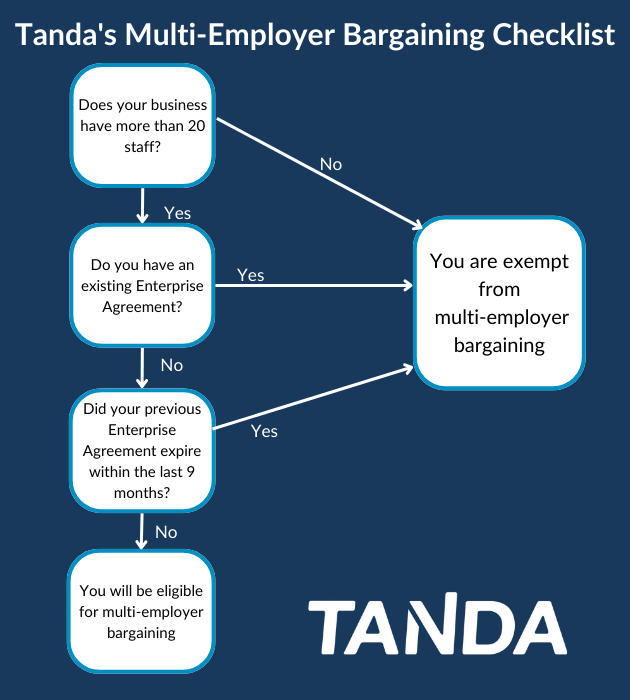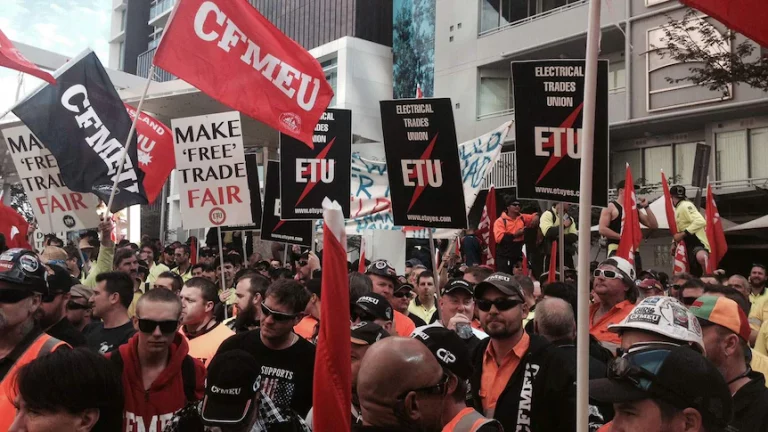Tanda has been closely watching recent Federal Government legislation which will introduce multi-employer bargaining for small and big businesses alike. Among businesses we’ve spoken to, there is major concern about how these laws might apply to them. The biggest concern is that smaller businesses could be dragged onto union deals – which hasn’t happened in the past.
The Federal Government has passed the bill, which will soon come into force. While the final details will be worked out in the courts, we now have a rough idea of how the new system will work. We’ve drawn up a quick guide for businesses looking to see if they might be drawn into this new scheme.
What is multi-employer bargaining?
Before we get into the depths of whether your business might be dragged into multi-employer bargaining, it’s important to remember what it is. Multi-employer bargaining means that many businesses negotiate a single deal with a union, rather than each business striking an individual deal. It is sometimes called industry-wide or pattern bargaining.
Currently, most businesses have their wages set via the Award system, which sees Fair Work set wages each year. Bigger businesses negotiate individual deals with unions for pay and conditions. The new system would see many businesses that don’t negotiate a new individual deal forced onto the multi-employer deal.
Of course, it’s not just negotiations that change under this plan. Unions negotiating arrangements with businesses have the right to strike in certain circumstances. Multi-employer bargaining would allow these strikes to occur across many businesses, in a major expansion of strike power.
Will small businesses be made to join multi-employer bargaining?
Hundreds of thousands of Australian small businesses could be made to join multi-employer bargaining. While there is an exemption for businesses with 20 staff or less, there are still many small businesses with more than 20 staff. These businesses could be forced to join the stream by a simple majority vote. Whether that happens in practice will depend on whether unions can organise a successful vote in individual workplaces. If they have 50 staff or less, they can also argue that they shouldn’t be forced to join.
The three types of multi-employer bargaining
There are three “streams” that businesses can be drawn into as part of multi-employer of multi-employer bargaining: the supported (low-paid) stream, the cooperative (opt-in) stream, and the single interest stream. As a basic rule, the three could be described like this:
- The single-interest stream allows workers with common interests to bargain together and force businesses to negotiate with them.
- The supported stream compels businesses in low-paid industries to negotiate with a union.
- The cooperative stream allows businesses to opt-in to deals that they like.
Who is exempt?
There are a few key exemptions that are important to remember:
- Employers that already have any kind of enterprise agreement won’t be forced to join multi-employer bargaining. Likewise, businesses that are bargaining in good faith for an enterprise agreement will be exempted.
- Small businesses with 20 employees or less won’t be forced to join the single-interest bargaining stream. However, they can still be forced into the supported stream for low-income workers.
- Employers with an Enterprise Bargaining Agreement that has expired will likely have a grace period of nine months to strike a new agreement before being forced onto multi-employer bargaining.

The Single-Interest Stream
The single-interest multi-bargaining stream is definitely the most controversial element of the Federal Government’s entire industrial relations plan. It is called the “single interest” stream because it allows workers in the same industry to bargain together if they have a “single interest”.
If you’re wondering what exactly a “single interest” is, the Government’s legislation doesn’t define it accurately and it’s probably going to turn into a lawyers picnic in the courts. At a recent Senate inquiry, University of Adelaide law professor Andrew Stewart said he was concerned the bargaining stream was “ill-defined, big, new, open-ended and hard to assess”.
While we don’t know who exactly will be included, in practice, the process will probably end up working a bit like this:
- Unions hold a vote in a workplace for whether to join a multi-employer bargaining stream.
- If workers vote to join the multi-employer stream, the Fair Work Commission would then rule whether it’s the appropriate stream for them.
- Businesses with 50 staff or fewer would have the opportunity to appeal to the Commission and argue that they shouldn’t be in that stream.
- The business would either join the existing multi-business agreement, or join the negotiations for a new agreement.
There are still many questions that need to be answered about how this process will work – for example, how will businesses come to an agreement to accept the union offer? Will it be by majority vote? How many votes will each business have? These are all outstanding questions that will be clarified in the months ahead.
The Supported (low-income) Stream
The supported multi-employer stream is for workers in low-paid industries, like aged care, disability care, and childcare. This stream is far simpler than the single-interest stream. A bargaining representative entitled to represent employees can apply to Fair Work for authorisation to bargain by simple majority vote.
The Cooperative (Opt-In) Stream
The cooperative stream is for employers who like an existing agreement and want to join it. This option shouldn’t be dismissed out of hand. Some agreements will have favourable changes for businesses – for example, longer permitted opening times in return for higher pay. These arrangements might suit some businesses who will choose to opt-in to the agreement. However, empowers with a current enterprise agreement would not be able to opt-in.
How will the negotiations work?
We don’t know yet. It’s likely that businesses will have to vote to accept or reject deals, but how this will actually work is still up in the air.
Will the new industrial relations laws allow industry-wide strikes?
Yes, industry-wide strikes will be legalised. Unions will have to take employers to conciliation before striking, and give 120 hours notice for strikes, but will then be able to strike across the entire interest stream as part of negotiations.
When will the laws come into effect?
The secure jobs better pay bill has passed and will come into effect in December 2022.
Changes to the Better Off Overall Test
The Better Off Overall Test (BOOT) will be changed as part of the Government’s reform package. The BOOT is a test that stops agreements from going ahead that will leave any workers worse off. However, the Government believes the test is currently too rigid. It blocks agreements based off what workers might receive under a deal if they work in certain circumstances, rather than what work is actually done. The Government has watered down this test to only include workers who actually work for the employer. The final details will be settled by the Fair Work Commission.






